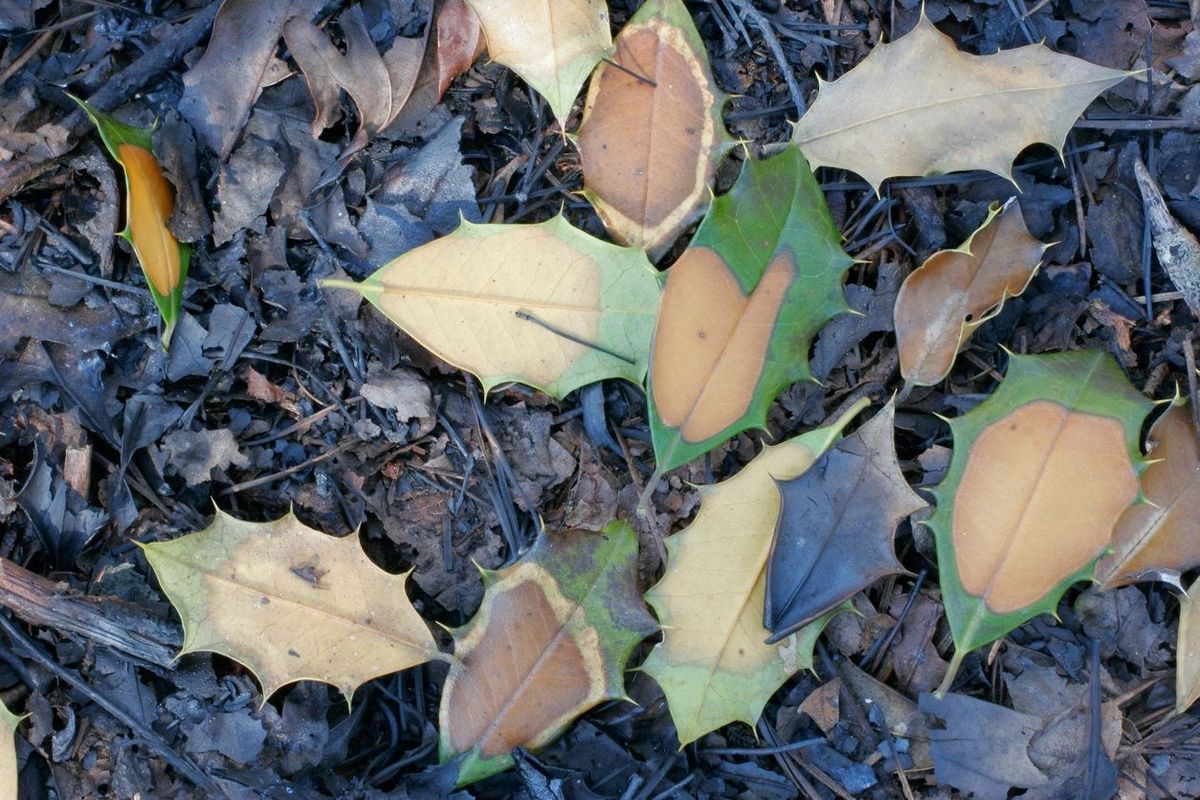Hollies are prized for their glossy evergreen foliage and cheerful red berries that add festive flair to gardens and landscapes. But sometimes those seemingly endless leaves start dropping off, leaving behind bare branches. This can alarm any holly lover. However, leaf loss is perfectly normal and understanding the natural growth cycle of hollies explains this behavior.
Hollies Are Evergreen But Not Permanent
Hollies are classified botanically as broadleaf evergreens, This means they keep their foliage year-round rather than shedding all leaves in autumn like deciduous trees, But evergreen doesn’t imply the leaves are permanent Hollies naturally drop some older leaves at certain times as new growth emerges
In spring hollies undergo an annual leaf exchange. The oldest inner leaves turn yellow and drop away making room for fresh new leaves to emerge. As long as the leaf loss is contained to the interior and the outermost leaves remain green, this seasonal shedding is perfectly healthy.
Typical Leaf Loss Pattern
During normal spring leaf drop:
- Older leaves on inner branches turn yellow first.
- Yellowing spreads gradually deeper into the canopy.
- Affected leaves drop cleanly from the branches.
- Outermost branch tips retain green leaves.
- Leaf loss occurs relatively rapidly over 1-2 weeks.
- No more than 30% of leaves are shed.
- Holly resumes normal appearance as new leaves grow.
As long as this general pattern occurs, usually in spring, the leaf drop is nothing to worry about. Think of it as the holly rotating its wardrobe for the new season!
Factors Prompting Leaf Loss
Hollies drop more leaves than usual when under stress, including:
- Insufficient water – Drought causes leaves to dry out and drop.
- Poor drainage – Excess moisture damages roots, preventing leaf growth.
- Extreme cold – Freezing temperatures injure leaves, which later turn brown.
- Pest/disease damage – Leaf spots, mites, and blights cause leaf loss.
- Root disturbance – Damage to roots from construction, tilling, etc. reduces leaf growth.
- Over-pruning – Cutting too much of the canopy prompts heavy leaf drop.
- Transplant shock – Newly planted hollies may shed more leaves as they establish.
Problems with Excessive Leaf Loss
While some leaf drop is expected, losing most or all leaves is problematic. Issues include:
- Bare branches are unsightly and lack privacy.
- Loss of foliage damages the plant’s health over time.
- Lack of leaves means no nutrients from photosynthesis.
- More pruning is required to restore shape.
- Berries lack foliage support and may not form properly.
Caring for Hollies and Their Leaves
To prevent excessive leaf loss:
- Water hollies during drought, keeping soil moderately moist.
- Improve drainage in overly wet soil.
- Protect from harsh winter wind and cold.
- Control diseases and pests promptly.
- Avoid root damage from construction activities.
- Prune judiciously, only as needed.
- Allow 1-2 years for transplants to establish before pruning.
Enjoy Hollies Despite Leaf Loss
Don’t despair when holly leaves blanket the ground in spring – it’s all part of the plant’s natural cycle. With proper care minimizing stress, the leaf loss will be temporary. Soon your holly’s beautiful branches will be cloaked in glossy new foliage just in time to provide a perfect backdrop for the beloved red winter berries.

Dead Leaves May Not Mean The Branch Is Dead
However, dont rush to prune out branches because they may not really be dead. Plants may exhibit discolored leaves but still have live buds. Once the ground thaws and the shrub can absorb water through its roots, it may recover. One way to tell whether a branch is alive is to gently scratch a small nick in the bark with your thumbnail. If you see a green layer beneath the outer bark, the branch still is alive. Although it may drop its damaged leaves, it will flush new ones in the spring.
If you do have sections of dead branches, you should prune them out. Hollies are very tolerant of being pruned and will often re-sprout even if they are cut to the ground. Many people do not prune their hollies as they like the symmetrical shape they naturally assume. However, they tolerate pruning very well. Wait to prune your holly until it begins to show new growth in the spring. At this point, you can prune out the dead tissue above the new, emerging leaves.
All About Holly Bushes | Ask This Old House
FAQ
Do holly bushes stay green all year?
Holly is one of the most popular broad-leaf evergreens. It’s deep-green glossy leaves look great in the garden all year round, and the winter bonus of bright red berries really brings color and interest at a low time in the garden.
Do holly bushes lose their leaves in winter?
It’s true that (most) Hollies are evergreen plants, keeping their leaves throughout the winter instead of dropping them like deciduous plants. But even evergreen plants drop some old leaves every year. Usually these leaves are dropped from the interior of the plant.
Will holly leaves grow back?
Although it may drop its damaged leaves, it will flush new ones in the spring. If you do have sections of dead branches, you should prune them out.
What are the downsides of holly bushes?
